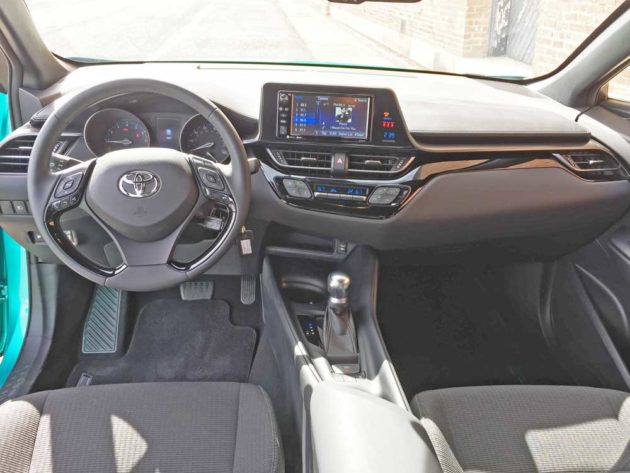?2108 Toyota C-HR XLE”
A Fun, Mischievous approach to the Subcompact SUV

What?s in a name? In the case of the 2018 Toyota C-HR, the name is somewhat ambiguous and contradictory. ?C-HR? according to the Toyota suits stands for ?Coupe-High Rider? That?s all well and good, but names, even in the form of acronyms should be appropriately descriptive and C-HR?s implied meaning is not.

For starters, a Coupe is a closed two-door vehicle while the C-HR has four doors, even though the attempt was made to cleverly hide the rear door handles by having them inset and positioned up high at the trailing edge of the door in body color. Next, the term high High-Rider is generally applied to vehicles with an exaggerated ground clearance and ride height as with most off-road vehicles. The C-HR comes with a normal ride height and stance and is only roughly 2-inches taller than the Yaris from Toyota.
In design terms, let?s just say that it?s unusual and borders on funky, sort of in the same genre as Nissan?s Juke and Cube, the defunct Pontiac Aztek, Honda?s HR-V, and a couple of ill-fated Scion models. It?s actually bigger than both the Juke and HR-V. Some will think that it?s ?cute?, others will dub it as ugly, and still others will find it especially alluring. The fact of the matter is, that it?s all of the above depending on that?s doing the beholding. Most of all, it?s intended to be fun, adventurous and futuristic, and it is. It?s not likely to be mistaken for any other vehicle by any other manufacturer.

Power is on the short side to provide an exhilarating motoring experience. Motive energy come from a transversely mounted 2.0-liter, DOHC, 16-valve inline four-cylinder front engine with Valvematic and electronic Direct Ignition. Energy is transferred to the front wheels via a Continuously Variable Transmission with intelligence and Shift Mode. A manual gearbox is not available, nor is AWD available. The engine only makes 144 horsepower at 6,100 rpm, while generating 139 pound feet of torque at 3,900 rpm. Not a lot to muscle around its 3,300 pound mass in either of its trim levels: XLE and XLE Premium.

The Premium trim and R-Code are essentially the only options, with the Premium trim bumping up the price roughly $2,000., which adds keyless entry, push-button start, heated front seats, Blind Spot monitoring and Rear Cross-traffic Alert. The $500. R-Code adds a white-painted roof with a red, blue or Iceberg Radiant Green metallic body, which is available only with the R-Code option.


My test Toyota C-HR was in XLE trim and came with the bright Iceberg Radiant Green metallic body and the R-code white roof. The base price was set at $22,500., but it came with removable cross bars, a universal tablet holder, TRD oil cap, carpeted floor and cargo mats, mudguards, an emergency assistance kit, rear bumper protector and wheel locks ? stand alone additions that bumped the final tally to $24,969. Standard ?Easter Eggs? ? quilted door panels and an embossed leaf-pattern headliner.

SUMMARY: The 2018 Toyota C-HR XLE is a unique 5-door hatchback that marches to its own drummer. It isn?t likely to be mistaken for anything else on the road and for some that will likely be a big plus. Chances are that one will either love it or hate it. It seems to appeal more to women than to men, with its questionable qualities.
It?s not a ?Hot Hatch? as it stands in terms of performance, but it could be by adding turbocharging and a conventional automatic transmission with paddle shifters. Acceleration is adequate for most driving scenarios, but for more passion and fun, more power would certainly be appreciated. There?s a Sport mode buried somewhere in the screen program that?s supposed to improve the throttle mapping, but a more accessible push button would be better.
Another shortcoming for many – techno geeks especially, it needs to include the availability of Toyota?s Entune, Apple CarPlay and Android Auto

The front seats are comfortable as is the ride quality. The steering is responsive, but there seems to be a numb or flat spot in the middle ? nothing serious to be concerned about, which only requires familiarization.

The back seats are tight if there are tall individuals up front, and the outward visibility is limited, especially for small children.

In the final analysis, while the C-HR may not be everybody?s cup of tea, it has a certain charisma that I found to be basically a positive attribute. Is it perfect? Nothing really is. Is it a good value? Yes. It is what it is ? a fun, funky crossover-like ride that will appeal to a lot of consumers.
SPECIFICATIONS: 2018 Toyota C-HR XLE
Base Price: $22,500.
Price as Tested: $24,969.
Engine Type and Size: 2.0-liter, DOHC, 16-valve inline four-cylinder with Valvematic and electronic Direct Ignition
Horsepower (bhp): 144 @ 6,100 rpm
Torque (ft./ lbs.): 139 @ 3,900 rpm
Transmission: CVT with intelligence and Shift Mode
Drive Train: Transversely mounted front engine / FWD ? electric power assisted.
Suspension: Front – Independent MacPherson strut with 26 mm stabilizer bar, coil springs, and hydraulic shock absorbers.
Rear – Double wishbone with coil springs, trailing arms,26 mm stabilizer bar and hydraulic shock absorbers.
Brakes: Power-assisted four-wheel discs (vented front) with ABS, BA, EBD, VSC, TRAC and Smart Stop Technology.
Tires: Dunlop SP Sport 5000 ? 225/50 R18 95V A/S mounted on 5-?Y?-machine face spokes with gloss black painted inners.
Wheelbase: 103.9 inches
Length Overall: 171.2 inches
Width: 70.7 inches
Height: 61.6 inches
Curb Weight: 3,300 lbs.
Turning Circle: 17.1 ft.
Fuel Capacity: 13.2 gallons
EPA Mileage Estimates: 27 mpg city / 31 mpg highway
Drag Coefficient: Not listed
0 – 60 mph: Not tested
 Arv Voss is a Northern California based freelance motoring Journalist and member and past officer of several noted Automotive Journalist organizations who contributes regularly to a number of national and international media outlets. He reviews not only cars, trucks and SUVs, but motorcycles and unusual wheeled vehicles as well.
Arv Voss is a Northern California based freelance motoring Journalist and member and past officer of several noted Automotive Journalist organizations who contributes regularly to a number of national and international media outlets. He reviews not only cars, trucks and SUVs, but motorcycles and unusual wheeled vehicles as well.








